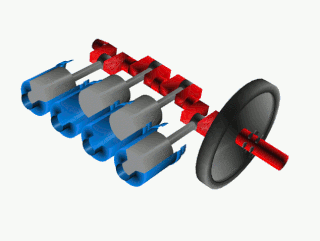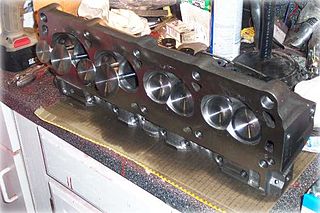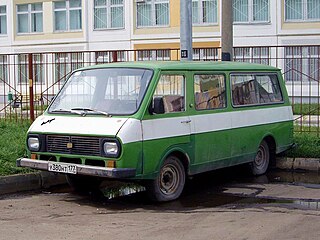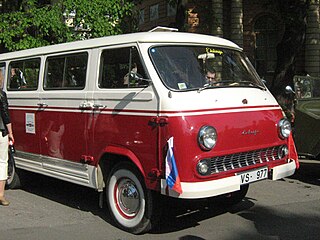The Moskvitch DM (also known as UMZ-412 or UZAM-412) was an automobile engine developed by Avtomobilny Zavod imeni Leninskogo Komsomola (Lenin Komsomol Automobile Factory, AZLK) under the Moskvitch brand, for the Moskvich 412. [1]

An engine or motor is a machine designed to convert one form of energy into mechanical energy. Heat engines, like the internal combustion engine, burn a fuel to create heat which is then used to do work. Electric motors convert electrical energy into mechanical motion, pneumatic motors use compressed air, and clockwork motors in wind-up toys use elastic energy. In biological systems, molecular motors, like myosins in muscles, use chemical energy to create forces and eventually motion.
AZLK was a Soviet and Russian automobile manufacturer (Moscow), the maker of the Moskvitch brand.
Design of the 1,478 cc (90.2 cu in) [2] DM began in response to the increasing power of Western Europe's competitors to the just-introduced Moskvitch 408. [3] The existing engine's displacement could not be enlarged profitably, so the AZLK team, led by Igor Okunev, started with a clean sheet. [4] It had a very stiff five-bearing crankshaft, and a very high-mounted camshaft (resembling the Hillman Avenger). [5] Oknuev, drawing on his experience in motorcycles, saw he could eliminate pushrods and raise the top rev limit, to 5,800 from the earlier engine's 4750. [5]

The Moskvitch-408 series is a small family car produced by the Soviet car manufacturer MZMA/AZLK between 1964 and 1975. The first prototype was made in 1960.

Engine displacement is the swept volume of all the pistons inside the cylinders of a reciprocating engine in a single movement from top dead centre (TDC) to bottom dead centre (BDC). It is commonly specified in cubic centimetres, litres (L), or cubic inches (CID). Engine displacement does not include the total volume of the combustion chamber.

A crankshaft—related to crank—is a mechanical part able to perform a conversion between reciprocating motion and rotational motion. In a reciprocating engine, it translates reciprocating motion of the piston into rotational motion; whereas in a reciprocating compressor, it converts the rotational motion into reciprocating motion. In order to do the conversion between two motions, the crankshaft has "crank throws" or "crankpins", additional bearing surfaces whose axis is offset from that of the crank, to which the "big ends" of the connecting rods from each cylinder attach.
The cam was chain-driven, and the block, head, sump, rocker cover, intake manifold, and other parts were aluminum. [5] It weighed only 146 kg (322 lb), just 6 kg (13 lb) more than the previous 1,360 cc (83 cu in), but produced 75 hp (56 kW ; 76 PS ). [5] It had removable cylinder liners, with both the aluminum oil pump and distributor driven off the crankshaft. [2]

In an internal combustion engine, the cylinder head sits above the cylinders on top of the cylinder block. It closes in the top of the cylinder, forming the combustion chamber. This joint is sealed by a head gasket. In most engines, the head also provides space for the passages that feed air and fuel to the cylinder, and that allow the exhaust to escape. The head can also be a place to mount the valves, spark plugs, and fuel injectors.

Horsepower (hp) is a unit of measurement of power, or the rate at which work is done. There are many different standards and types of horsepower. Two common definitions being used today are the mechanical horsepower, which is about 745.7 watts, and the metric horsepower, which is approximately 735.5 watts.

The oil pump in an internal combustion engine circulates engine oil under pressure to the rotating bearings, the sliding pistons and the camshaft of the engine. This lubricates the bearings, allows the use of higher-capacity fluid bearings and also assists in cooling the engine.
Prototype engines were delivered in 1964. [5] It was tested in racing in summer 1966, before entering full production, in a higher tuned state, producing 92 hp (69 kW ; 93 PS ), in the Moskvitch G4M racer. [5]
The Moskvitch G4 were sports cars from Moskvitch released in 1963. Like the G3, they used the same engine as the Moskvitch 407. In 1965, all three G4's were re-engined with units based on the engine in the Moskvitch 408. These engines were fitted with twin Weber 40DCO carburettors, advanced valve timing, and new camshafts giving 81 bhp. The G4's were then redesignated as G4A's. A G4A was fitted with a Moskvitch 412 based engine, the DM, rated at 92 bhp, leading to the G4M. During 1967-1968, the two remaining G4A's were converted into G4M's. Two G4M's were rebuilt into Moskvitch G5's in 1968. The third G4M was raced until 1972. The G4's had independent suspension, both front and rear, and were successful in several USSR championships.
It was produced by Ufa Motorniy Avtomobilny Zavod (Ufa Automobile Engine Factory, UZAM), and the first production engine was completed 15 March 1966. [2] It was first used in the Moskvitch 412 in March 1967. [2] It was also supplied to IZH, which also assembled the 412. [2]

The Moskvitch 412 is a small family car produced by Soviet/Russian manufacturer MZMA/AZLK in Moscow from 1967 to 1975, and by IZh in Izhevsk from 1967 to 1982. It was a more powerful and prestigious version of the M-408 model, offering more features for a higher price.
The planned 1975 Moskvitch 356 was to use an enlarged 1,799 cc (109.8 cu in) version of the DM, with twin Zenith carburetors, giving 103 hp (77 kW ; 104 PS ). [6] None was built. [6]

The zenith is an imaginary point directly "above" a particular location, on the imaginary celestial sphere. "Above" means in the vertical direction opposite to the apparent gravitational force at that location. The opposite direction, i.e. the direction in which gravity pulls, is toward the nadir. The zenith is the "highest" point on the celestial sphere.
This was followed by the 1975 four door fastback Moskvitch C1 (Series One), with a 1,702 cc (103.9 cu in) version of the DM, offering 81 hp (60 kW ; 82 PS ). [7] It inspired the Moskvitch C3, which was very similar but a five-door hatchback. [7] The engine would have been fitted at an angle from the vertical (like the Chrysler slant six). [8] Neither project reached production. [6]










